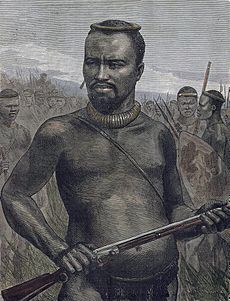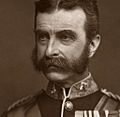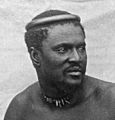Battle of Isandlwana facts for kids
The Battle of Isandlwana was a major fight that happened on January 22, 1879. It was the first big battle between the Zulus and the British Empire. This war between them is known as the Anglo-Zulu War.
The British army, led by Lord Chelmsford, marched into Zululand. About 20,000 Zulu warriors attacked the British camp at Isandlwana. Over 1,300 British soldiers were killed. The Zulus also lost many brave fighters, between 1,000 and 2,500 men.
This battle was a big surprise for the British. It was followed by another famous fight where the British successfully defended a place called Rorke's Drift.
The war was mainly between the Zulu nation and the colonial government of Natal. Natal was a British colony that later became part of South Africa.
Contents
What was the Anglo-Zulu War?
The Anglo-Zulu War was a conflict between the British Empire and the Zulu Kingdom in Southern Africa. It happened in 1879. The British wanted to control more land in Africa. They also wanted to bring all the different kingdoms and colonies in the region together under their rule. The Zulus were a powerful and independent nation. They did not want to give up their freedom. This led to a big clash between the two sides.
Who fought at Isandlwana?
The main groups fighting were the British army and the Zulu warriors. The British forces included soldiers from Britain and local African allies. They were led by Lord Chelmsford. The Zulu army was made up of brave warriors. They were fighting to protect their homeland and their king, Cetshwayo.
British Forces
The British army at Isandlwana included soldiers from the 24th Foot Regiment. They were well-trained and had modern weapons like rifles and cannons. However, they were surprised by the large number of Zulu warriors.
Zulu Warriors
The Zulu army was known for its strong discipline and fighting skills. They used traditional weapons like spears (called assegais) and shields. They fought in a special formation called the "buffalo horns," which allowed them to surround their enemies.
The Battle Unfolds
On the morning of January 22, 1879, the British army was camped near a hill called Isandlwana. They did not expect a major attack that day. Lord Chelmsford had split his forces, looking for the main Zulu army.
A Surprise Attack
While many British soldiers were away, the Zulu army launched a massive surprise attack. They quickly surrounded the British camp. The Zulus greatly outnumbered the soldiers left at the camp.
Fierce Fighting
The fighting was very intense. The British tried to form defensive lines, but the Zulus kept pushing forward. The British had trouble getting enough ammunition to their soldiers. This made it harder for them to fight back effectively.
Zulu Victory
After several hours of fierce combat, the Zulus overwhelmed the British forces. Many British soldiers were killed, and the camp was completely overrun. This was a huge and unexpected victory for the Zulus. It was a shocking defeat for the powerful British Empire.
Aftermath of Isandlwana
The Battle of Isandlwana was a major turning point in the Anglo-Zulu War. It showed that the Zulus were a formidable fighting force.
Impact on the War
The British were shocked by their defeat. They had underestimated the Zulus. This battle made the British send even more soldiers and resources to Zululand. They were determined to win the war.
Rorke's Drift
Later on the same day, a small group of British soldiers successfully defended a mission station called Rorke's Drift. This battle happened just hours after Isandlwana. The defense at Rorke's Drift became famous for its bravery.
Images for kids
-
Cetshwayo, c. 1875
-
- 94 the flag of the 24th Regiment (2nd Warwickshire) (Post-1881 Childers Reforms known as the South Wales Borderers).
See also
 In Spanish: Batalla de Isandlwana para niños
In Spanish: Batalla de Isandlwana para niños









